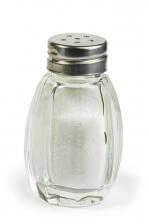Sodium High
Why you might want to watch your salt intake, even if you don’t have high blood pressure.

The recommended maximum intake for sodium is about 2400 mg a day, which is roughly one teaspoon of table salt. Most Americans eat about twice that much, and that upsets the people whose job it is to worry about your health. And I’m not just talking about your mother and me. There are whole government agencies that lay awake at night worrying about your sodium intake.
Their main concern is that eating a lot of salt can raise your blood pressure, and that can be quite dangerous. Now, in all honesty, a high-sodium diet doesn’t lead to high blood pressure in everyone, and some people have high blood pressure even when they eat a very low-sodium diet. But public health policy is all about playing the numbers. The government figures that if everyone ate less salt, fewer people would develop high blood pressure, have strokes, and die, and that would be a good thing.
But if you don’t have high blood pressure, does it really matter how much sodium you eat? Actually, it may matter more than you think.
Other Reasons to Curtail Your Sodium Intake
Eating too much salt can also affect the health of your bones. When you eat a lot of salt, your body ends up losing more calcium through your urine. To compensate, your body draws on its calcium reserves—your bones. So, a high-sodium diet can be a risk factor for developing osteoporosis. This is especially true if you’re not getting enough calcium in your diet.
On a more cosmetic note, eating a lot of salt can cause your body to retain extra water weight. Retaining water isn’t the same thing as gaining weight because you’re eating too many calories. But it can still make your jeans tight. The good news is that water weight is a lot easier to lose than fat. You can simply reduce your sodium intake.
Where Does It All Come From?
Earlier, I said that the recommended daily maximum for sodium is about one teaspoon of table salt. And you may be thinking to yourself, “Hey, I don’t put salt on anything! I haven’t filled my salt shaker in ten years. I’ve got nothing to worry about.”
Not so fast! If you’re like most people, about three quarters of the sodium in your diet doesn’t come out of the salt shaker. It comes from packaged and processed foods like soups, spaghetti sauce, canned vegetables, frozen entrees, and deli meats, as well as the obvious sources like chips and other salty snacks. Even foods that don’t taste particularly salty, like cereals and cookies, can contain a surprising amount of sodium.
Even on a healthy diet, it’s really easy to max out your sodium allowance. A cup of black bean soup, ten pretzel twists, and a salad with Italian dressing and you’re already well over the limit for the entire day!
Restaurants and take-out foods are also notoriously high in sodium—especially Chinese, Mexican, Indian, and fast foods. So, it’s really not surprising at all that most of us are eating about twice as much salt as we probably should.
Salt Cured
So, here’s what I want you to do: First, just start tuning in to the hidden sodium in your diet. You’ll find the sodium content listed on the nutrition facts label of every packaged food. The label also tells you what percentage of your daily sodium allowance a serving contains.
Start noticing which foods are particularly high in sodium and make a note to eat them in moderation. Or, better yet, choose alternatives with less sodium. For example, low-fat tortilla chips have less than half the sodium of pretzels. Shredded wheat has about a quarter the sodium of corn flakes. And so on.
You can also use the nutrition facts labels to keep a rough tally and budget your sodium intake as you go through the day. (Conveniently, foods that don’t come with nutrition facts labels, such as fresh fruits and vegetables, tend to be very low in sodium.)
Second, choose the low-sodium option whenever possible. You can buy low-sodium versions of soups, salad dressings, sauces, canned tomatoes, deli meats, nuts, and lots of other foods. If they don’t taste salty enough for you, you can add salt to taste and they will still be lower in sodium than the full-sodium versions.
Third, if you have time, make your own. Home-made soups, sauces, stir-fries, salad dressings, and baked goods are almost always lower in sodium than store-bought or restaurant-prepared.
Finally, hedge your bets by getting plenty of calcium and potassium, which help to compensate for the negative effects of too much sodium. You can increase your intake of both nutrients by eating more fresh fruits and vegetables, especially dark green and leafy veggies.
Administrative
Is sea salt better than table salt? Find out here.
This is Monica Reinagel, the Nutrition Diva, with your quick and dirty tips for eating well and feeling fabulous.
These tips are provided for your information and entertainment and are not intended as medical advice. Because everyone is different, please work with your health professional to determine what’s right for you.
I am also on Facebook and Twitter.
If you have a nutrition question for me, send an email to or leave me a voice mail at 206-203-1438. And if you’ve been enjoying this podcast, I have a favor to ask. Nominations for the 2008 Best Podcast award are underway now at . You can vote for your favorite podcast once every 24 hours, so vote early and often!
Thanks for listening. Have a great day and eat something good for me!
RESOURCES:
Salt Shaker image courtesy of Shutterstock

